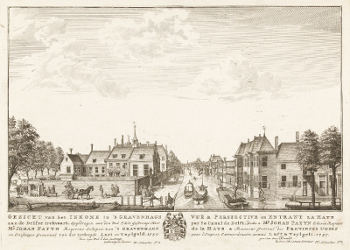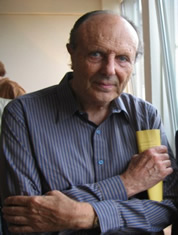This study will set out in well considered detail the high probability that Vermeer's The Art of Painting did indeed, as suspected by some scholars, come to Vienna in 1745 at the time that Gerard van Swieten (1700–1772) took up his position as Empress Maria Theresa's personal physician. In addition, it will show that the Dutch doctor could not have come into possession of this painting if, in the immediate years following Vermeer's death (1675), the artist's wife, Catherina Bolnes, and his mother-in-law, Maria Thins, had failed to keep his masterpiece safe in Delft. As will be presented, there developed a chain of events set in motion by Maria Thins which resulted in the painting leaving the Vermeer family to eventually come into the ownership of two Van Swieten generations.
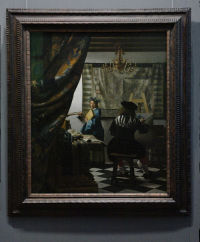
c. 1667–1668 Oil on canvas, 120 x 100 cm.
Kunsthistorisches Museum, Vienna

The Art of Painting (1667–1668) (fig. 1 & 2) by Johannes Vermeer has had a chequered history. This does not mean that it suffered long journeys because for the greatest part of the first three hundred years of its life the work had—apart from short trips to Munich and, on Hitler's order, the salt mines at Altaussee during the Second World War—not left its home, Vienna, since 1745. As will be shown, its only long journey was one from Leiden to the Habsburg capital. What is conveyed by "chequered history" are those occasions when the painting became a bone of legal contention during its early years in Delft, and meant, too, are the many question marks that can be put over the work's exact location in Delft and Leiden—and even Vienna. The subject of this paper is the string of little "events" in this painting's early life, those seemingly unimportant occasions where it was part of a transaction, whether on death, on purchase, or as the exchange of goods. No other of Vermeer's paintings was so reluctant to leave Delft; it finally disappeared in March 1677 and seemingly dropped out of history for good.
John Michael Montias in Vermeer and His Milieu: A Web of Social History states the following before he tackles the artist's non-documented years of apprenticeship: "It is a proper object of speculation, in my view, to suggest sequences of events that are consistent with the more or less established facts at our disposal. The more tightly the facts can be fitted the better for our speculation, but magic slippers will not be found that provide the perfect fit. The important thing is to identify conjectures and not let them be confused with solid facts."1 Similarly, this present paper will perhaps not offer an answer to every question but will put forward well considered conjectures as well as carefully weighed assumptions based on documentary evidence and on an understanding of human common sense and artfulness; it shall also state one important, highly significant, new fact that throws fresh light upon the painting's provenance. The paper, too, shall disclose a new aspect regarding the guardianship over Vermeer's children as well as highlight a crucially important decision made by Vermeer's mother-in-law, Maria Thins.
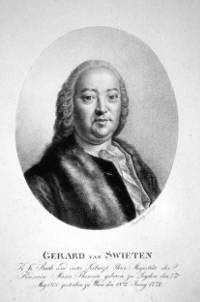
Josef Lanzedelly
c. 1830
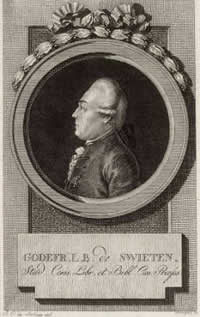
Johann Georg Mansfeld (after drawing by Lakner)
c. 1790
Etching
The story moves back through time and, before it reaches the last quarter of the seventeenth century, stops for two moments, first in the early nineteenth century when The Art of Painting re-entered the records,2 then in the mid-eighteenth century when Gerard van Swieten (fig. 3) settled in Vienna. The Art of Painting was acquired by Johann Rudolf Count Czernin (1757–1845) (fig. 5) of Vienna, who, according to a diary note by his son Eugen Karl, "bought it for 50 florins in bad bank-billets after [Gottfried] Van Swieten's death"; the count understood the work to be by Pieter de Hooch3 whose false signature had been applied. The auction sale of the estate of Gottfried van Swieten (1733–1803) (fig. 4) was announced in May 1804.4 Eugen Karl's entry, made over thirty years later (12.4.1837), does not state in which year his father acquired the painting, in other words does not establish whether he bought it at aforementioned auction or not. Scholars have long maintained that Czernin acquired the work in 1813 and bought it from a saddler.5
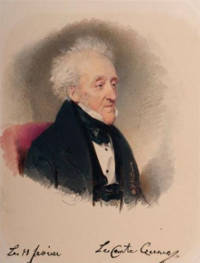
Moritz Michael Daffinger
c. 1840
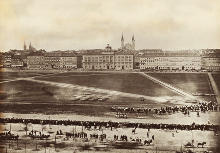
Czernin, a keen collector, filled nine rooms of his palace with great paintings and they were put on public display—Vermeer's masterpiece, now called The Atelier by Peter van Hooghe [sic] included; his picture gallery opened shortly before his death in 1845. An 1846 Baedeker informed visitors that a viewing of the Czernin collection could be achieved on enquiry with the concierge in exchange for a tip.6
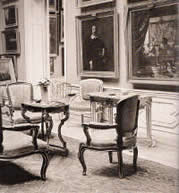
It is not known when De Hooch's signature was put on the canvas. After Vermeer's death, and through the inevitable dispersal of his paintings, many of his works lost their connection to him and in certain cases were given signatures by other artists.7 Misattributions were common, even understandable; deliberate falsification, however, more pernicious.
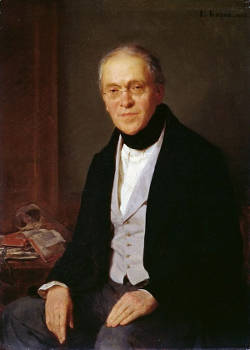
Ludwig Knaus
1855
Oil on canvas, 54 x 40 cm.
Alte Nationalgalerie, Berlin
Following a lead given by Berlin Museum director Gustav Waagen (fig. 6), critic and "Vermeer chaser" William Thoré-Bürger—who by 1860 had virtually doubled the number of accepted works by the Delft artist 8—confirmed that the Girl Reading a Letter at an Open Window in Dresden, then attributed to De Hooch, was by Vermeer. At the same museum he climbed a ladder to study The Procuress labelled as by Jacobus van der Meer of Utrecht.9 Diana and her Companions in the Mauritshuis had been attributed to Nicholaes Maes. Thoré-Bürger (fig. 7), who had not seen The Art of Painting,10 made the correct Vermeer attribution in the 1859 Arenberg catalogue and Waagen, who came face to face with the painting, his subsequent confirmation of this in 1860.11 According to a label on the frame and a guide to the Czernin collection it was painted by "Peter van Hooghe."12 As only under half of the Delft master's paintings are signed,13 and few Vermeers had been properly attributed by 1860, the neglect of detailed study and observation is understandable.14
Another drawback in making a proper assessment of the painting's state and provenance in the nineteenth century is due to the fact that after the Second World War the Czernin family unsuccessfully claimed the return of the work, which had been sold to Hitler in 1940, and this prevented the Kunsthistorisches Museum from acquiring any earlier documentary material about the conservation work or framing done when it stayed in the Czernin collection [1845–1933 ].15
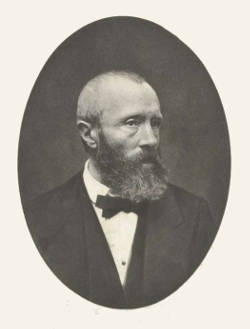
Anonymous
1880–1900
Paper, 10.7 x 7.8 cm.
Rijksmuseum, Amsterdam
However, recent research with infra-red reflectography [IRR] revealed that the painting bore a false De Hooch signature put on the lower cross support of the stool.16 Similar examination by IRR has also detected the date, applied by the artist, immediately following his signature below the map, and can be interpreted as MDCLXVI (I I ?) – 1666-7-8, most likely 1668 based on the spacing and extent of overpaint. This confirms the date long suggested by several scholars. The lettering is consistent with the inscriptions in both The Astronomer (1668) and especially The Geographer (1669).17 So when or why was the painting deliberately attributed to Pieter de Hooch? That is a question on which an answer will be ventured later.
The Art of Painting arrived in Vienna in 1745, on 7 June to be precise, for that was the day Gerard van Swieten and his family set foot on Viennese soil.18 Due to hostilities between Bavaria and Austria during the War of the Austrian Succession, the family could not sail down the Danube, a faster journey and less exhausting, and so, Saxony being an Austrian ally, journeyed via Leipzig, (and probably Dresden and Prague).19
Van Swieten, newly appointed personal physician to the empress Maria Theresa and her family, reformer of the Medical School, censor, and appointed prefect of the imperial library, had left Leiden at the beginning of May.20 Already in the spring of 1743 Van Swieten had been invited by Count Kaunitz, chief minister of Charles of Lorraine, Governor of the Austrian Netherlands, to work at the Habsburg court in Vienna, but had initially rejected the offer. However, after having received many persuasive and generous letters from the empress, he made up his mind and accepted the new position in a letter sent to Vienna on November 9, 1744.21 Whilst this letter was on its way, the eminent doctor received an urgent call from Kaunitz to come to the Brussels court where the empress's dearly loved sister, Marianne, wife of Charles of Lorraine, lay mortally ill.22 Van Swieten, though a great man and a polymath,23 was unable to save the princess; Marianne died on December 16th. One might have thought that this was the end of Van Swieten as far as Vienna was concerned. However, Maria Theresa was attracted—as so often this natural autocrat was attracted—by the Dutchman's independence of mind;24 his manner, his Roman Catholicism, (her physician had to be a pupil of Boerhaave and a Catholic), his capability and candidness had made a profound impression; she found she could confide in him.25
It has been often repeated that The Art of Painting ended up in Vienna because Van Swieten was "greatly interested in the arts."26 The plural diminishes the likelihood. The eminent doctor certainly enjoyed music, played en famille, he had mastered the bass viol and taught his children music; he very occasionally frequented a theatre performance, an opera or masked ball, but only in his early years in Vienna when the empress persuaded him. Such entertainment was too much for him.27 Apart from music, his biographers Korst and Brechka show the physician's love of literature and books but do not mention pictorial art anywhere, probably for the simple reason that Van Swieten did neither; the doctor enjoyed study, science, reading in ten languages and reciting poetry. Gerard van Swieten was an extremely busy man.28 He slept 5 hours a night and every other hour was filled with work. Still, even if he was interested in "the arts," it is very unlikely that he came into possession of The Art of Painting through purchase back in Holland because in Leiden the doctor, though certainly not poor, had lived modestly and spent his money mainly on his family, books, study and charity.29
We now travel back seventy years. Johannes Vermeer died in Delft on December 13 or 14, 1675 and during the aftermath of his demise The Art of Painting disappeared. The painter's widow Catharina Bolnes and his mother-in-law Maria Thins tried their utmost to keep the work in the family. Their financial difficulties are described sufficiently well elsewhere, and we will be concise.30 The creditors were at the door of their house on the Oude Langedijck and Catharina made an effort to pay off the family's debts while holding on to the works her husband had two objectives that weren't always compatible.
On the February 10, 1676, twenty-six paintings, probably the greater part of Vermeer's stock as art dealer, were seemingly sold to another artist-cum-dealer Jan Coelenbier (1610–1680) for 500 guilders.31) It is extremely unlikely that this deal included The Art of Painting for reasons that will become clear. Vermeer's stock was disposed of to pay a debt the family owned to a Jannetje Stevens for shop wares, but she owed Coelenbier money. Coelenbier purchased them "for the account and in the name of Stevens"32 and stocked the goods in his Haarlem house as security since he had claims on the shopkeeper; he intended to settle the difference with her by giving her goods or money.33
Two weeks later, on February 22 or 24, 1676, in order to reduce the debts she owed to her mother, Catharina Bolnes transferred The Art of Painting to Thins in the office of notary Johan Vos in The Hague. This date alone makes the sailing of The Art of Painting to Haarlem very unlikely. The picture could not be transferred if it had already been "sold." And if mother and daughter were so intent to keep the work, why sell it? The transferral date was chosen because the inventory of the estate was imminent, on the 29th and, indeed, the work is not listed in its records. The Art of Painting now belonged to Thins and could stay safely at the Oude Langedijck.
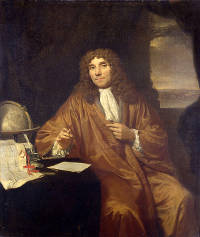
Jan Verkolje
Between 1670 and 1693
Oil on canvas, 56 x 47.5 cm.
Rijksmuseum, Amsterdam
Weeks passed. On 24 April, Catharina pleaded poverty and petitioned the high court for a moratorium on her debts. It is granted the same day: she was declared bankrupt. Five months later the scientist Anthony van Leeuwenhoek (fig. 8 was appointed curator of the Vermeer estate (September 30, 1676). The father of microbiology set about his task methodically. The tangled web of the estate's finances and those of the Thins family took some sorting out. Catharina would tell the court in another petition the year after (1677) that she had never had to think about anything other than housekeeping and her children. But how things had changed! There was 2,900 guilders on deposit in the Orphan Chamber of Gouda; property in and around Gouda and Oud Beyerland, (south of Rotterdam). There were inheritances and obligations transferred to Catharina from her brother or given by her mother. And then there were the many debts; nor had the matter with Coelenbier and Stevens been sorted out. Van Leeuwenhoek most likely suspected that the two women had been trying to keep in the dark about Catharina's real assets.34 At his behest he had the Delft magistrates send an attorney to The Hague to question Thins about the matter of an inheritance (unrelated to Vermeer's estate) on November 9, 1676.35 It was a time when notaries were kept very busy—Van Ouwendijck, Vos, Hendrick Terbeeck van Coesfelt, Boogert and others.
Of these, we turn our attention briefly to the figure of Hendrick Terbeeck van Coesfelt [Coesfelt]. He worked as a notary—later also attorney, land agent and rent collector—in The Hague from 1674 to the end of 1726, where he died in February 1727. Coesfelt was born in Utrecht on March 2, 1647. The family was Roman Catholic and had lived in Utrecht since the Middle Ages. His father Bernard and grandfather Henrick had both been notary and attorney in the city.36
Coesfelt's first recorded involvement with the Vermeer family occurred on April 28, 1676; his last on June 27, 1708. Thirty-five out of the forty-seven notarial documents between these two dates—as listed by Montias in his book Vermeer and his Milieu37 — involve notary Coesfelt, directly or indirectly. (28 documents are from his own records; in seven he appears as witness or attorney). In September, 1676 Thins draws up her fourth testament in his office, revoking all three preceding wills.38 From his first appearance that late April, 1676 until mid-March 1677 Coesfelt assisted Thins and Bolnes on eight occasions. We shall return to notary Coesfelt in due course.
Meanwhile Van Leeuwenhoek kept busy making enquiries. In order to reduce the family's debt, Vermeer's stock of 26 paintings that had been with Coelenbier was due to be sold at auction at St. Luke's Hall, Delft, on March 15, 1677; the sale would include The Art of Painting which had been confiscated by the curator who had posters printed advertising the event. Three days before this, on 12 March, Maria Thins sent Van Leeuwenhoek a letter via her notary protesting that The Art of Painting was due to be sold.
We now turn to the matter of this sale—of which no records exist—and the letter Thins sent to Delft that 12 March. The eighty-four year old who at the time resided in The Hague with her cousins Aleyda and Cornelia van Rosendael paid a visit to Johan Vos in whose office ownership of The Art of Painting had been transferred by her daughter just over a year earlier.39 Thins composed a letter of "insinuation"40 in which she reconfirmed that the painting belonged to her. The old woman was in a great hurry. She had, probably that same day, received news (from Catherina in Delft?) that Van Leeuwenhoek had confiscated The Art of Painting or/and she had received one of the bills advertising the auction to be held at St. Luke's Hall in three days. Obviously she had very little time in which to act.
In Delft the matter was dealt with by notary Van Ouwendijck who met Van Leeuwenhoek the day after (13th) and read him Thins's letter. The curator countered that he had been able to get hold of the 26 paintings Bolnes sold to Coelenbier—just over a year ago—only by lawsuit. This lawsuit took place six weeks earlier on February 2, 1677; at that time the paintings were still in Haarlem. After due payment to Jannetje Stevens (who could then pay her debt to Coelenbier), the pictures were sailed down to Delft and obtained by Van Leeuwenhoek who now wanted his money back, including the cost of the lawsuit. As stated, this lot of 26 paintings did not include The Art of Painting for Bolnes could not have sold it to Coelenbier to then transfer the picture to her mother.
Her son-in-law's masterpiece had been taken away from her house to be sold. Perhaps Maria Thins expected this outcome for though she did protest at the upcoming sale of the painting, she did not utter any surprise that it had come into Van Leeuwenhoek's possession. She—more involved with inheritance, legal suits, rent, estates and notaries than, it would appear, any other citizen in Delft—knew that curators visited creditors and made enquiries, (or had notices printed that creditors of the estate of Johannes Vermeer were requested to notify him). The curator had power. For instance, on 30 November,1676, Coelenbier, alerted by Stevens, had visited a local Haarlem notary and declared the transaction with Bolnes.41 Why at this juncture, nine months after the event? Most probably because Van Leeuwenhoek, recently appointed, had visited Stevens on whose urgings—by now she may have waited years to get her money—Jan Coelenbier made his declaration. ["at the request of Jannetje Stevens"]. Stevens must have knocked and entered the dwelling on the Oude Langedijck on various occasions in the past to have her bills settled42, perhaps had met Vermeer and, though progressing no further than the front hall (het voorhuis), had seen the once luxurious now rather shabby turned interior of the house; she may well have informed Van Leeuwenhoek that there was more than those pictures sent to Haarlem. No doubt the curator himself must have paid regular visits to question the women, have progressed beyond the front hall, have seen the interior, perhaps Catherina's quarters as well as her mother's (he had authority) and may well have seen The Art of Painting on the wall. He most likely must have asked to see copies, if any, of notarial documents drawn up since Vermeer's death. And so was presented with the act of transferral drawn up by Johan Vos. (If this did not occur on the Oude Langedijck, then a notice from the notary's office in The Hague set matters in motion). Such a sketch sets an entirely plausible event. That is what was meant by "those seemingly unimportant occasions" in this painting's life at the start of this essay.
The curator regarded the transfer of the work from daughter to her mother invalid on the grounds that Bolnes and Thins had made an attempt to defraud the creditors, for they had, in knowledge of the upcoming inventory February 29, 1676, in effect secreted the painting away. On that basis he impounded the picture. It would explain the reaction of Maria Thins who, as stated, did not utter any surprise that the curator had got hold of the work; the only surprise was that, in addition to the other pictures, he wanted to sell "her" painting, too.
Van Leeuwenhoek continued and told Van Ouwendijck that, if Maria Thins wanted the painting returned, she should invoke her rights of preference, i.e. that she was a creditor with a prior claim on the repayment of debts due by the estate43 and put in a claim as preferential creditor. The sale, however, would still take place the day after tomorrow.
If Thins was prepared to put forward such an opportune claim—and, given her own and Catherina's attachment to Jan's best painting, it is difficult to imagine the alternative—she would have had to do so immediately. Given her contentious nature, strong character, and determination to keep the painting in the family, it is entirely plausible that she took this chance straightaway—although a day may have passed because, staying in The Hague, she had to wait for Van Ouwendijck's reply. It was not in her nature to dawdle; she was (or needed to be) always one step ahead. That 14 March must have been frantic. Her claim was submitted and filed, awaiting approval. As will become evident, the court's authorization of such an application could take a long time. During this period the painting, removed from the sale, may have been kept aside, residing in limbo, until such time that Thins's preferential status as creditor was granted or denied. Or if it was sold, the buyer would have had to wait before he could take full possession of his purchase.44
As an illustration of the court's slow deliberation on the matter of preferential creditor we note that eighteen months later, November 16 [or 26], 1678, Thins authorized attorney Frans Boogert45 to represent her as plaintiff seeking status as preferential creditor with respect to other creditors of the late Johannes Vermeer.46 Seven months passed before authorization was given. A court sentence on July 3, 1679, awarded her this favoured status.47
So, going back eighteen months, if Thins had filed the abovementioned application of preferential creditor of The Art of Painting on or just before March 15, 1677, approval or rejection could, if such matters took seven months, only have been granted in the autumn of that year. Given such bureaucratic sluggishness it can be reasonably conjectured that this indomitable old woman, who undertook these actions to play for time, did manage to forestall the sale of the painting.
Another illustration of leisurely bureaucratic advance can be given. After March 1677, when the painting is believed to have disappeared from history, it still was, two and a half years later, though not mentioned by name, the subject of discussion, instigated by Maria Thins, naturally.
On October 23, 1679, Thins drew up a procuration to help her carry out the sentence of preferential creditor given on 3 July, claiming she had not been repaid for any of the debts her daughter had acknowledged she owed her back in February 1676. Thins declared with a solemn oath "that the sums spent on the repayment of death debts of Johannes Vermeer had been expended by her and not from moneys in the estate of aforementioned Johannes Vermeer and Catherina Bolnes, directly or indirectly, and that she has not been repaid for them. Similarly the items in the accounting or liquidation of February 22 [or 24], 1676 [the day The Art of Painting was "transferred" from daughter to mother] which she had claimed from her daughter … were still owed to her by her daughter." [italics added].48
She made it appear that the matter of the painting had not yet been dealt with to her satisfaction. The trouble about the transferral over three and half years ago still rankled. Although the "items in the accounting" would in the main include parcels of land and life annuities,49 nothing is specified and one can therefore reason beyond mere conjecture that Thins did include other chattels and the painting. Of course, if the work had been put up for auction and sold—and lost to her—she would not have been able to do so. All this legal manoeuvring was not aimed at Catharina, naturally, but meant to protect the family assets from the creditors represented by Van Leeuwenhoek.50
Concerning the transfer of The Art of Painting, Montias states that one would not normally expect a person to go before a notary to cede a piece of property to her mother.51 Perhaps, but their economic plight and their deep attachment to the work made such action a necessity. As stated, the purpose was to keep the painting safe from creditors and the women hoped that by Catherina visiting the notary they would give their plan greater weight and authority rather than the exchange of a promise by word of mouth. Notary Vos did not seem to have made an objection and it appeared to have been legally binding, else he would have dissuaded her. However, it is curious that Bolnes travelled to The Hague to see a notary not dealt with before or since.52 Vos would not have known Vermeer (he misspelt the name) nor the dire financial circumstances of the family; a notary in Delft (most of whom may well have sighed at the name Maria Thins) more than likely would have.
If the painting was again (or had remained) the property of the family by late October 1679 Thins would have been successful in keeping it for her next of kin. The eighty-six years old did not lay claim to the work, she did not want it for herself; nor did she insist that her daughter paid off the sums and value of properties to her. The matriarch acted solely to secure the future of her grandchildren, to rebuff creditors and all judiciary authorities. A few months later she made her sixth and last testament and died Christmas 1680.
Van Leeuwenhoek, whose last recorded act as curator took place in November 1682,53 did not chase after the painting; perhaps most creditors had been satisfied or he knew that those debts still outstanding could be paid off from other sources. As stated, it is not known what happened to the painting after the March 13, 1677, it disappeared for the next 68 years. However, as will be shown, it seems highly probable that The Art of Painting could not have come into the hands of Gerard van Swieten if it had left the Vermeer family.
Meanwhile Hendrick Terbeeck van Coesfelt continued to look after the affairs of the painter's family. Hendrick and his forebears came from Utrecht where, as mentioned, his father Bernard (died November 30,1674) and grandfather Henrick had been notaries and attorneys. Grandfather had been a secular canon.54 Canons belonged to the upper echelon of the city and often were sons of the nobility, of patricians and wealthy citizens. They were understood to live celibately but forty to fifty percent did not follow this rule. These secular canons as the Coesfelts must have been, marrying and procreating, were often worldly; the vast majority had a university education and they earned good wages.55
I highlight the Coesfelts' background in notes 54–56 to show their thorough Roman Catholicism, a vital aspect for Maria Thins who had fiercely objected to her daughter marrying Vermeer unless the artist became a Catholic. Given the fact that Thins had relations in Utrecht amongst whom the painter Abraham Bloemaert (1566–1651), social connections, equal patrician standing and the Roman Catholic faith may have brought her and notary Coesfelt together and bonded further trust. Hendrick's father, Bernard, had drawn up acts for Cornelius and Hendrick Bloemaert, sons of Abraham. In turn, Bernard's father had acted for Abraham himself.56
On September 23, 1686, Ignatius Vermeer, the painter's youngest child, fourteen years old, signs, in a firm, mature hand, the first of many acts he would witness in the next three years for the notary who was to become his guardian almost two years later.57 One can only guess why the minor was in Delft. Perhaps he, his siblings and Catharina, had come up from the catholic city of Breda, where they had lived since 1684, for a visit or else he was staying alone at his sister Maria, Vermeer's first child, who was married to a Johannes Cramer. From the document one gains the impression that Coesfelt was in Delft on separate business, recognized the boy, and called him over as witness. It suggests they had met before and the notary instilling confidence and trust in the youngster. Neither would be disappointed. Indeed, Coesfelt would use Ignatius to witness acts on further occasions.
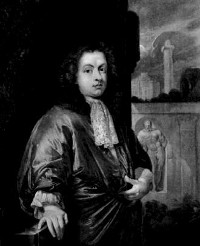
Caspar Netscher
1657
Oil on canvas, 45 x 54 cm.
Collection Koch-Hartmann Stichting, Delft
On December 27, 1687, three days before her death in Delft where she had returned to visit her daughter Maria or, perhaps, to die, Catharina Bolnes appointed Coesfelt the guardian of her minor children, appearing to make a sudden change in guardianship from Hendrick van der Eem (fig. 9), Orphan master in Delft, to the notary in The Hague. Montias does not know why she took steps to remove Van der Eem. Weighty reasons, he claims, must have moved her. Catharina was perhaps not coherent and this makes the wording of her last testament a little confusing.58 Montias considers it the one independent decision of her life59, but queries its cause. However, although dying, Catharina was lucid enough: Hendrick van der Eem had died and been buried a few months earlier on July 21, 1687.60 Still, Montias makes a valid point because Catharina had not been in contact with Coesfelt for six-and-a half years, July 1681. But she did have a "weighty reason." On her deathbed she appointed notary Coesfelt, "both out of her own volition … and also pursuant to the will and desire of her late mother, Maria Thins." [italics added] In the past mother and daughter must have often discussed the best course for the children's future and the italicized words capture the women's agreement perfectly. Even if Van der Eem had still been Orphan Master, Coesfelt would have been favoured. Usually so elegant with a pen, Catharina could only manage a scratch for a signature which notary Van Ouwendijck identified as hers.61 Vermeer's widow was buried on January 2, 1688; the burial register notes that she still had five minors—that is, children aged under twenty-five and unmarried.62
Coesfelt sprang into action. In June 1688 the Breda debts owed by Catharina Bolnes were repaid by him63; as guardian he must have had to make many other such payments. In May of the same year he acted as representative to Johannes Cramer, Catharina's son-in-law. In May 1689, Vermeer's son Franciscus, who, married and thus not in need of a guardian, took out a loan witnessed by the notary; a little later he and his wife also made their wills in Coesfelt's office. The notary continued to manage their financial affairs. In 1698, Ignatius and Franciscus empowered their guardian to act on their behalf in a suit involving a house on the Spui in the centre of The Hague in which the notary had invested 1,500 guilders on their account.64 By this date Vermeer's children were all older than twenty-five, (the youngest, Ignatius, had reached maturity in 1697) but they continued their trust in him; indeed, as shown, even the artist's older children and son-in-law used his authority. They must have known one another well with the Delftenaren regarding the older man their friend.
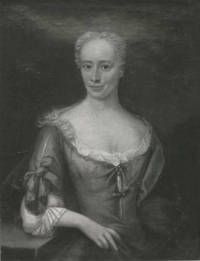
We have given this sketch of Hendrick Terbeeck van Coesfelt for very good reasons, as will now become apparent. The notary married twice and had a son from his first marriage, Geofroid (Godefridus) who, like his father, became an attorney. Geofroid married a Judith van Geffen.65 They had three children, two daughters and one son.66 The youngest daughter, who concerns us here, was Maria Lambertina Elisabeth Theresia (fig. 10), born July 2, 1712, at The Hague, who, on September 27, 1729, just seventeen, married, in the Roman Catholic Church on the Appelmarkt in Leiden, the twenty-nine year old doctor Gerard van Swieten.67
This single fact offers an important and highly relevant connection, and a therefore persuasive explanation, of how The Art of Painting ended up in the Van Swieten family: Maria Terbeeck van Coesfelt's grandfather became notary of the Vermeer family soon after the artist's death; he gained guardianship over the minor children for whom he acted until at least June 1708, by then he had assisted the family for 32 years. I do not know how The Art of Painting came to be in Coesfelt's possession, but there must have existed a high degree of mutual trust. I have illustrated how Thins managed to keep or regain possession of it shortly before, or soon after, the auction held at St Luke's Hall.68 It is entirely possible that Coesfelt was handed the work in lieu of payment for his bills until the time that it could be reclaimed by the family, or else was given it in trust by Bolnes—or by Maria Thins whose painting it now was—with the stipulation that it was to be used after her / their death(s) as capital for the development of her / their grand/children. It is difficult to imagine Catharina taking the painting to Breda where she had moved in 1684 with her eight children and lived in very poor circumstances, regularly borrowing money she was unable to repay.69
On the death of Hendrick in 1727 the painting would probably have come to his only child, Geofroid, but there was no time to distribute the inheritance (if any) because Geofroid died on 1 April, about six weeks after his father. The deaths of father and grandfather in such a short period brought upheaval: the family Terbeeck van Coesfelt visited the office of notary Van Aken in The Hague eight times that year, doubtless concerning Hendrick's estate, and causing Geofroid further grief and stress, leading to his early death.70 Unfortunately, none of the abovementioned visits to Van Aken state any inventory or possessions of Hendrick or Geofroid.71
It would appear that during 1727, a year of enormous changes and reorganisation of possessions to the doubly bereaved family, The Art of Painting, which her grandfather had quite probably owned for nigh forty-five years, came to Maria. Or else, the girl being only fourteen, one can conjecture that it was given her, now more mature and married to a prominent doctor twelve years her senior, on her wedding September 27, 1729.72
Returning now to the misattribution of The Art of Painting as a work by De Hooch, four possibilities can be proposed. Assuming that the work had been in the possession of the Coesfelt family in The Hague for about forty-five years (Maria Thins died December 1680, Bolnes December 1687) and that subsequently the Van Swieten-Coesfelt family must have known its provenance, it seems unlikely that the picture was falsified during the eighteenth century—what ground would any of them have had? It is stated that during this century The Art of Painting was attributed to and given the signature of Pieter de Hooch.73 However, if the work hung at Gerard and Maria's, a very private family, how (or why, if the work was "still" a Vermeer) would such attribution have developed? Perhaps by the time their son Gottfried came to own it, i.e. after the death of his mother in 1784, the work may have received a wider audience given his many "high society" contacts. Gerard died in 1772. Gottfried would not have had the need to falsify the picture for financial gain (and what other reason can there be?), he was as wealthy as his father had grown after arriving in Vienna. This first option can therefore be discounted.
What price did a painting by De Hooch fetch in the early nineteenth century? Was the 50 florins Czernin paid a reasonable sum? Did falsification take place shortly before the May 1804 auction? That is the second option. The practice of some art dealers selling various artists' works under the names of other painters to get a better price was nothing new. In assessing the authorship of any painting of the seventeenth century, it is important to remember that many of them, including Vermeer's, changed hands during the following centuries at prices that made them of less value to their owners than a good suite or a Sunday dress. It is not in the least surprising that they were treated with little respect—that backgrounds were sometimes painted over, objects and figures changed according to the owner's taste and pieces cut off to make them fit a frame or particular niche. Such an owner of even a Vermeer, whose name, other than to a few connoisseurs, meant as good as nothing, would not have had any qualms about hiring another painter to falsify a signature than a person today would think of having a chair re-upholstered.74
It is unjust to tar a person whose name one doesn't even know, but until his existence and ownership of The Art of Painting (or The Atelier by Pieter de Hooch) as well as the sale of it to Czernin, has been documented, the saddler cannot be discounted having put on De Hooch as a lucrative alternative.
The fourth, least plausible, possibility is that the signature was falsified some time after 1677 in order to put creditors on the wrong track—and after Van Leeuwenhoek had finished visiting the Oude Langedijck where, there can be little doubt, he must have seen the painting for he had the authority of inspection. As an artist and art-dealer Vermeer may very likely have told the family about cases of falsification. Bolnes and Thins would be aware of such offence. The women could counter in their defence that it was their picture. It would have been a desperate act, but a creditor claiming Jan's painting would leave empty-handed. The "I Ver-Meer "and the "MDCLXVI" ["I I"] were overpainted, the De Hooch applied; the damage, for so it must have seemed, could be corrected once danger had passed. De Hooch had lived and worked in Delft 1655–1660 and it is possible that in this instance both painters' styles were regarded as sufficiently similar.
It is not known when the "I Ver-Meer" was repaired, probably around the time (early 1860s) when Waagen and Thoré-Bürger identified The Art of Painting as a work by Johannes Vermeer, still, it seems strange that the Roman numerals were not restored as well.75 In 1866 Thoré-Bürger came face to face with the painting and was the first to describe the "I Ver-Meer"76, but he did not mention the Roman date.
As regards the locations where Vermeer's masterpiece may have hung, matters can be brief. It is not possible to say precisely where Van Swieten lived in Vienna. When the family arrived in June 1745 it was allocated a house that bordered the Court Library. A memorandum dated June 22, 1749, indicates that he was living in Penzing, a district just north-west of Schönbrunn. A few years later, in 1753, his home was in the Hietzing district or at the Hietzinger Tor, a few hundred yards west of the palace.77
The Art of Painting came to be owned by Maria Terbeeck van Coesfelt through her father and grandfather; Gottfried van Swieten inherited it from his mother. Gerard died June 18, 1772 at Schönbrunn. Widow Van Swieten passed away March 9, 1784 at the age of seventy-one, her residence being Mariahilf, Goldener Hirsch 10. She had been granted an annual pension by the empress of 4,000 florins and firewood in winter. Above the portals of Mariahilferstrasse 45 (and Windmühlgasse 20) (fig. 11) a golden hind can still be identified today.78 It is likely that The Art of Painting had very handsomely furnished one of the rooms there.
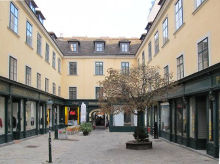
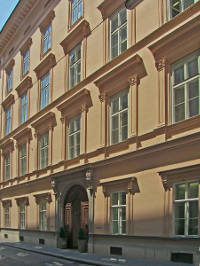
I don't know Hendrick Coesfelt's address in The Hague; it would be nice to place the house where Vermeer's proudest achievement may have hung for four decades or more.79 Gerard van Swieten and (since September 1729) his wife lived on the Steenschuur, Leiden,80 from 1728 to 1731 and from 1731 to 1745 on the Nieuwsteeg, a short street running south from the choir of the Pieterskerk in the centre (fig. 12). As for Breda, it seems unlikely that Catherina, in addition to her eight children, took The Art of Painting to the town. It would be very sad but touching if, impoverished as she was, borrowing sums she was unable to repay, amidst her poverty Jans' wonderful work sometimes made her feel the richest woman alive.
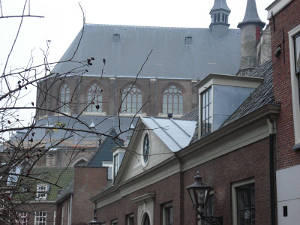
At the beginning I stated that this paper uncovered an important fact upon the whereabouts of Vermeer's proudest achievement, but, of course, the discovery made sinks into near insignificance when one considers how many new questions it raises. To quote Montias again: magic slippers have perhaps not been found, but "plausible hypotheses, if nothing else, narrow the area where future investigation may yield new finds."81
Further Considerations
A.
Tentative searches for documents that mention testaments of the Coesfelt family have been made in the hope that any of these would mention De Schilderkunst. [The Art of Painting]. The name Terbeeck van Coesfelt appears more than 170 times in the name index of the notarial archives of the Municipal Archives in The Hague. But in many instances the name is only used as reference. However, there still remain many documents concerning Hendrick yet uncharted. They may contain hundreds of acts. Unfortunately the majority of these cover the years after his death in 1727 and, again, his name (and Godefroid's) would be used as third party. The few exploratory efforts to find the name Vermeer or beyond this date did not bear fruit. If, as proposed, The Art of Painting was handed over to the notary, it seems unlikely that a relevant document exists.
B.
Searches in Korst or Brechka to see whether Van Swieten or his father, notary Thomas, had come into possession of The Art of Painting proved unsuccessful. I have been unable to consult the work by Wilibald Müller (1883), who wrote that Van Swieten "was greatly interested in the arts."
Not consulted either is the 1880 manuscript by Gerard van Swieten's last direct descendant, Egid van Swieten, which lingers unpublished in the Haus-, Hof- und Staatsarchiv in Vienna. (HHS, W 1012). Perhaps it may throw light on the time of Gottfried's death and the dispersal of his goods. But in 1880 Vermeer was not famous. One must resist the temptation to regard The Art of Painting and other works by Vermeer as instantly recognizable by a wider public even before the First World War. Given their present fame we somehow gravitate to the notion that people in the seventeenth, eighteenth and nineteenth centuries would have instant recall of the ‘studio scene' and of the name Vermeer as well. Wherever it was displayed, except for the Oude Langedijck in Delft, the painting hung anonymously, also at the Czernin Gallery until the 1860s; a very good and striking work, of course, but one of many.
C.
After all these considerations it would prove more than ironic if at the March 1677 auction Terbeeck van Coesfelt made a successful bid for the painting. He had been the family's notary for nearly a year, knew the straits it was in, and may have learnt about, and sympathised with, the women's dilemma, had admired the work and been prepared to reduce part of their debts at a stroke.
The possibility that Thins's nieces purchased The Art of Painting is put forward in footnote 44.
References: Abbreviations
GA. - Gemeente Archief Den Haag / Municipal Archive The Hague
KHM. – S. Haag, E. Oberthaler and S. Pénot (eds). Vermeer. Die Malkunst. "Spurensicherung an einem Meisterwerk." Vermeer, The Art of Painting. Scrutiny of a Picture. With English Translations of the Essays. St. Pölten / Salzburg, 2010. References are made from the English text.
M. - Montias, J.M. Vermeer and his Milieu. Princeton, 1989.
NL. - De Nederlandsche Leeuw, jaargang 58, 1940.
VS. - Vermeer Studies, eds. Ivan Gaskell and Michiel Jonker, National Gallery of Art Washington D.C., New Haven and London: Yale University Press, 1998.
† FOOTNOTES †
- M. p. 98
- KHM. ‘The painting did not resurface until more than one hundred years later [after 1677], when it was mentioned in the collection of the art enthusiast Gerard van Swieten as a work of Pieter de Hooch.' E. Oberthaler: The Art of Painting by Johannes Vermeer. History of Treatments and Observations. p. 322. No source is given. Gerard died in 1772. Perhaps his son Gottfried is meant. But was Gerard van Swieten an art enthusiast? (See notes 27 and 28).
- KHM. R. Juffinger and C. Brandhuber: The Unrecognised Masterpiece. Vermeer's The Art of Painting: the Story of its Provenance. p. 288. (30 florins in P.T.A. Swillens, Johannes Vermeer, Utrecht, 1950. p. 61). See also A. Blankert, Vermeer of Delft, Oxford, 1978. p. 163.
- KHM. p. 289. Quotes Wiener Zeitung, 5 May, 1804
- This date is still accepted. See KHM: A. Wheeler: The Art of Painting, p. 268 and B. Kriller-Erdrich: A to V: Arthur Strasser and Johannes Vermeer in the Kunsthistorisches Museum Vienna, p. 308, and E. Oberthaler, p. 322.
- KHM. E. Mongi-Vollmer: Rediscovering Vermeer's The Art of Painting in the 19th century. p. 303.
- KHM. R. Wald: The Art of Painting. Observations on Approach and Technique. p. 312.
- VS. F. S. Jowell: Vermeer and Thoré-Bürger: Recoveries and Reputation. p. 47.
- VS. p. 47.
- VS. B. Broos: Vermeer: Malice and Misconception. p. 20.
- VS. p. 47 and 55.
- VS. p. 19 and notes on p. 31.
- A.B. De Vries, Jan Vermeer van Delft, London, 1948. p.105.
- Waagen and Thoré-Bürger identified the work of Vermeer on its style, technique and colour. Thoré-Bürger, (who himself confused De Hooch occasionally with Vermeer) had, as mentioned, already identified some forgotten paintings by ‘Jan van der Meer de Delft' and understood The Art of Painting to be by Vermeer on the strength of a trusted authority; Waagen recognized it in person. See W. Liedtke: ‘Genre Painting in Delft after 1650: De Hooch and Vermeer', in Vermeer and the Delft School, ed. by W. Liedtke, New York, 2001. p.146.
- Author's correspondence with Kunsthistorisches Museum, Vienna, August 2002. (The Austrian Court decided in March 2011 that The Art of Painting would not be returned to Czernin's descendants).
- Research probably done at the Kunsthistorisches Museum 1997–2008. No date is given in KHM.
- However, with the Vienna canvas the numerals are executed in white paint rather than the black/dark blue colour in the Paris and Frankfurt works. See KHM. R. Wald, pp. 312–313. For an interesting observation on the retouching of the painting see Lawrence Gowing. Vermeer. Berkeley CA: University of California Press, 1997. p.143.
- According to his biographers. See F.T. Brechka, Gerard van Swieten and his World 1700–1772. The Hague, 1970. p. 97 an J.K. van der Korst, Een dokter van formaat. Gerard van Swieten, lijfarts van keizerin Maria Theresia. Amsterdam, 2003. p. 113. Both quote W. Müller: Gerhard van Swieten. Biographischer Beitrag zur Geschichte der Aufklärung in Oesterreich, Wien, 1883. ("Ein Plagiat ohne jeden selbständigen Werth," A. Fournier in Gerhard van Swieten als Censor, Wien (?) 1876. Fournier adds this criticism to his revised paper in a footnote on p. 52 in Historische Studien und Skizzen, Prag, 1885.)
- Korst. p.113. Austria and Bavaria signed a peace accord on 22 April, 1745 but this news came too late to change Van Swieten's plans.
- Korst. p. 67.
- Korst. p. 63. Brechka. p. 95.
- Korst. pp. 63–64.
- Crankshaw, E. The Habsburgs. London,1971. p. 174.
- Crankshaw, E. Maria Theresa, London, 1969. p. 199.
- Brechka. p. 97. The relationship became so trusting that in December of the following year Maria Theresa and her husband Francis served as god-parents at the baptism of the doctor's daughter. The child was named Maria Theresia Francisca Josepha. Despite the obvious flattery of the godparents it should be remembered that one of Van Swieten's sisters as well as his wife also bore the name Maria Theresia. See also Brechka. p. 114. who does not include this child on p. 70 where he lists the other children born to the Van Swieten couple. Coincidentally, Count Czernin's wife's name, too, was Maria Theresia.
- Blankert. [see note 3] p.164, who also quotes Müller, see note 18. 27
- Brechka. p. 114. Korst. p. 121.
- Brechka. p. 119. Korst. p. 127.
- Brechka. pp. 70–88.
- See the works by Swillens, Blankert, Bailey, de Vries, and, above all, Montias.
- Bailey, A. A View of Delft, London, 2001. 205–206.
- M. p. 219, doc. 362.
- See note 32.
- Bailey. p. 208.
- M. p. 226.
- NL. p. 95. Also author's correspondence GA, August 2002. In Utrecht's Roman Catholic St Pieterskerk is a memorial stone on the nave's south side which commemorates canon Hendrik van Coesfelt (d.1495) and his mother (d. 1458). The religious imagery above the text has probably been destroyed during the iconoclasms that took place throughout the Netherlands during 1566. See also notes 54–56.
- In what follows we have relied heavily on his ground-breaking work. See under M. All dates given are from his book.
- M. p. 224, doc. 368.
- Or Vosch, who worked in The Hague between 1653 and 1678. [GA, author's correspondence, January 2003.] Montias gives the Dutch text only in part, but Blankert (p. 152) and Swillens (p. 191) give it in full.
- This letter includes a sentence that draws our attention: ‘so the first notary [in Delft] requested to do so [instructed by authorities in Delft] shall present himself before Leeuwenhoek. But what does ‘ … the first notary requested …' [Soo sal den eersten notaris, hiertoe versocht …] mean? It does not appear that this letter was sent directly to Van Ouwendijck. Was it despatched to Delft town hall or the aldermen who would then appoint a notary? Whatever the case, Vos sent the letter to an appropriate office in Delft, confident that there would be a qualified notary available: (‘the first requested', i.e. authorised) would confront Van Leeuwenhoek. Swillens (or the translator – I have the English edition) seems to have noticed this, too, for he states: She [Maria Thins] gave the usher notice that the piece was her property. p. 34, italics added.
- M. p. 338, doc. 362.
- On 1 April, 1671 the family owed her seventy-two guilders for woollen cloths, see M. p. 219.
- M. p. 229.
- Here we put in a suggestion that, at her wits' end, Thins may have asked one or both of the sisters Rosendael to buy the painting at the sale, to return to The Hague where the work may have hung in their house on the Juffrouw Ida Straat. Aleydis and Cornelia van Rosendael were cousins of Maria Thins and devoted friends of the Vermeer family and, having financial means, known to settle many business affairs on behalf of Thins and her daughter. (Montias in VS, p. 103) The sisters were of great assistance to the Delft family, as Thins attested on many occasions. (see documents in M.).
- Boogert had handled many of Thins's affairs for nearly 20 years. (M. p. 233).
- M. p. 355, doc. 395.
- M. p. 233.
- M. p. 355, doc. 399. Thins re-iterates what she had already sworn in Coesfelt's office on 11 December, 1676: she had kept no assets of her daughter or … Johannes Vermeer in her possession in fraudem creditorem; neither is she in bad faith. (M. p. 347, doc. 375).
- Same document.
- M. p. 233.
- M. p. 219.
- M. The name appears in the index once.
- M. p. 235.
- See Utrechts Archief, inventory number U046a002. An act by notary Snelderweert of 6 May, 1669 states that ‘[Bernhard =] Beernt, son of Henrick Ter Beeck van Coesfelt who, when alive, was canon at St Pieters', Utrecht. Bernard's date of birth is not known. His father married a widow in Culemborg, ten miles south of Utrecht on the Rhine, on 8 June, 1616; he had been granted an ecclesiastical transfer to marry there. [See NL. p. 95.] Whether he ceased being a canon after his wedding and changed canon / ecclesiastical law to become a public notary and concentrate on secular law, one cannot tell. It is more than likely that Bernard's grandfather was the Hendrik Coesfelt alluded to in footnote 55 who had been expelled from Utrecht in 1586 and was found preaching in Cologne.
- Bogaers, L. and A. de Groot. ‘Van anonieme graven tot persoonsgebonden grafmonumenten. 7 eeuwen grafcultuur in de Utrechtse Pieterskerk'. Trajecta, vol. 11, number 3. Leuven, 2002. 211–243. Or see: p. 233. In 1587 Arnoldus Buchelius, humanist lawyer and antiquarian, met the exiled Utrecht canon and family friend Hendrik Coesfelt in Cologne preaching on free will and good works. Coesfelt and others had been expelled from Utrecht on 21 July, 1586. [see Pollmann, J. Religious choice in the Dutch Republic. The reformation of Arnoldus Buchelius (1565–1641). Manchester,1999. p. 78 and p. 220] This most likely is the same Hendrik / Henricus who is mentioned in the Kronijk van Utrecht or Traiectense ecclesiastici nobiles, [15761591], an anonymous Latin work written by a priest because it mainly concerns church matters. The visit of the Prince of Orange to the city, for instance, is mentioned only cursorily, as is Leicester's departure. Apart from Henricus Coesfelt, canon, also recorded are Floris Thin (the Dutch Court's representative, [Pensionary], to Utrecht, died 1595) and his son Johan, as well as Frans and Johannes Bogaert, dean – are these four, however distant, related to Maria Thins? [See genealogical tables in M. pp. 369–77]. See Historisch Genootschap. Kronijk van het Historisch Genootschap te Utrecht. Utrecht, 1865. Jaargang 21, 5e serie. pp. 561–62
- See Act of Bernard with Hendrick Bloemaert 30.9.1649. Act of Hendrik with Abraham Bloemaert 3 May, 1631. He also acted for Hugo and Adrian de Roy and, too, for members of the Duyst (or Duyff) van Voorhoudt family, all related to Thins. Hendrik was still alive 23 February, 1651 when he is mentioned in an act drawn up by Bernard concerning Adrian de Roy. On 28 October, 1650 Henrik witnesses an act in Bernard's office drawn up regarding the grandchildren of Alpherda de Roy. Further details see Utrechts Archief and links. See genealogical tables in M. pp. 369–377.
- M. p. 234, doc. 422. Boys could be witnesses at the age of fourteen, girls at the age of twelve.
- M. p. 237.
- Perhaps it was: she may have meant Van der Eem's successors, ("Orphan masters" - p. 361, doc. 426) for she does not mention him by name. Montias writes: ‘It is not known why she took the step of removing Van der Eem from the guardianship. Weighty reasons must have moved her, considering that this was one of the few independent decisions she made in her entire life, indeed the only one we know of.' (p. 237) Montias is too hard on Catherina Bolnes whose ‘unbridled fertility' (p. 245) he (nearly) blames for the family's hard times, forgetting to say that her husband's lust equally got them all in trouble. A house packed full with children – I think Bolnes did remarkably well, as perhaps Montias does acknowledge: ‘the survival to adolescence or early adulthood of 9 or 10 children out of 15' is an achievement. (p. 245) Even so, one shudders to think if Maria Thins had not been there.
- Onderzoek naar de familienamen de Bot, Both, Bod en Bodt. Het geslacht Both van der Eem. [users.skynet.be/andreboth/genealogie]. Van der Eem had his portrait painted by Caspar Netscher. Kollektie Koch-Hartmann Stichting, Delft.
- M. p. 361, doc. 426.
- M. p. 237.
- M. p. 237.
- M. pp. 239–241.
- ‘s-Hertogenbosch (Den Bosch) 7 July, 1710.
- NL. p. 95.
- NL. p. 95. Information confirmed by GA, The Hague, and mentioned in Brechka, page 70, who also cites the Leiden GA and local baptism- and wedding registers. The Appelmarkt St. Wilibrorduskerk, built 1641, was destroyed by a gunpowder explosion January 12, 1807.
- The possibility that the work was bought by one or both the sisters Van Rosendael for safe-keeping was raised in footnote 44.
- If the painting had been left behind in Breda, one ought perhaps check auction- and notarial records there.
- On 17, 29, and 31 March and on 14 May, 8 and 17 June, and 4 and 25 August, 1727.
- From the act of 29 March, 1727 it appears that Godefroi made a will on the 1 October, 1724, but this is no longer extant. GA, correspondence, March 2003. In a document by notary Van Aken, dated 4 August, 1727, mention is made that Hendrick ter Beeck van Coesfelt, son of Bernard, received 32,000 guilders from the legacy of his grandfather Henrick in Utrecht, also some furniture and family portraits, but no mention is made whether he (grandson Hendrick) owned De Schilderkunst. The canon must have been wealthy. The date of the legacy is not mentioned. Exactly one year after her husband's death Geofroid's widow, Judith van Geffen, (she never remarried) made a will on 1 April, 1728 in which she declared her three, still under-aged children -unless the law had changed by then from the one in force in the 1680s and early 1700s- as sole beneficiaries of her estate. Judith died in 1764. GA, correspondence, March 2003.
- Van Swieten was probably introduced to Maria by her younger brother Hendrik Bernhard, a student at Leiden at the time. Gerard and Maria shared similar background: her father, grandfather (The Hague) and great-grandfather (Utrecht) had all been notaries; Gerard's father, Thomas, (d. 1712) had been a notary in Leiden and The Hague. Here one may add another possibility and suggest that the painting was handed by Judith van Geffen as a farewell gift at the couple's emigration to Vienna. I can find no record that ‘Mama Coesfelt' bequeathed the work to Maria at her death in 1764.
- KHM, p. 312. See note 8. No dates or catalogues nor evidence of public acclaim are given.
- Koningsberger, H., with H.W. Janson and C. Seymour, The World of Vermeer, New York, 1967. p. 169.
- KMH, p. 105. See illustration by Adolph Görling of P. van Hooghe's Atelier, 1864 [?], (after Waagen's and Thoré-Bürger's identification), without signatures or date.
- W. Bürger (T. Thoré): ‘Van der Meer de Delft' in Gazette des Beaux-Arts 21, Paris, 1866. p. 326.
- Brechka. p. 142 and Korst. p. 115.
- Brechka. p.143.
- He is not listed in Guide de la Haye, The Hague, 1705, though it lists notary Thomas van Swieten, father of Gerard, on p. 30.
- The neighbourhood was destroyed in 1807 by the explosion of a barge carrying munitions. (see also note 69).
- M. p. 98.
